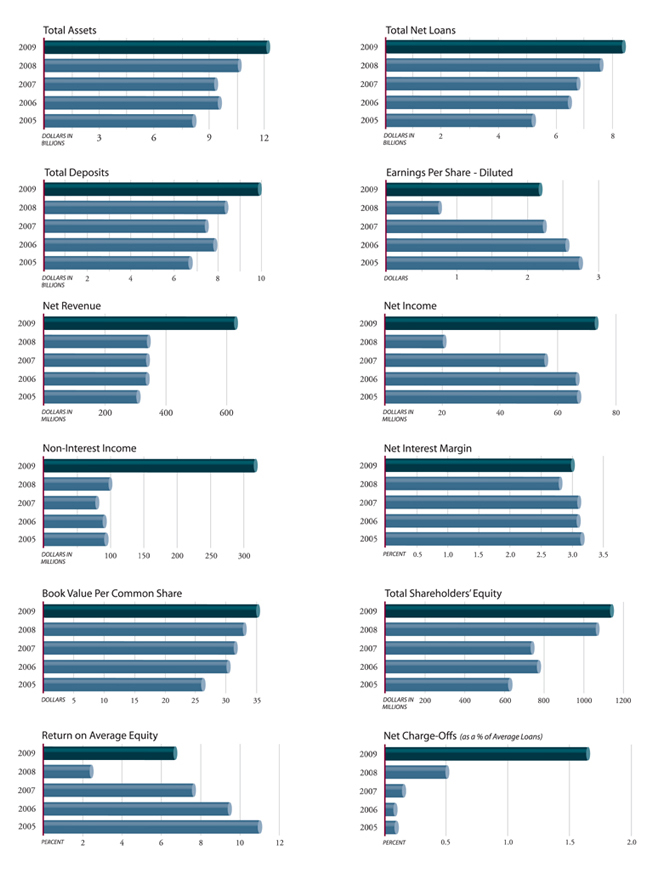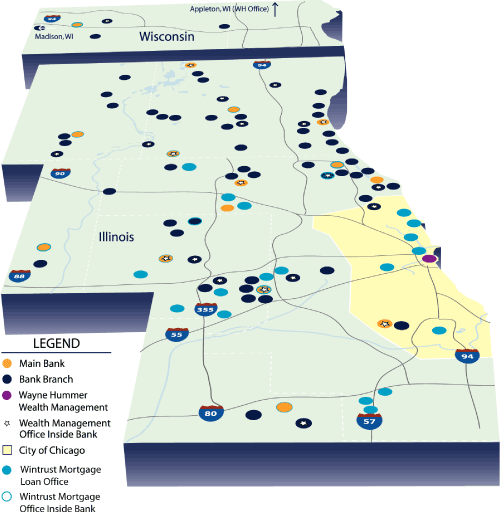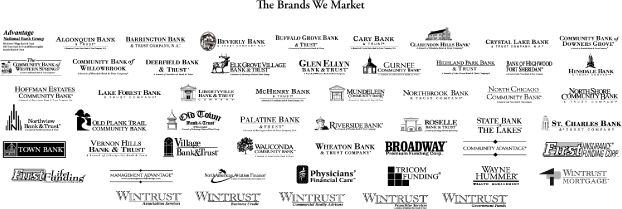Attached files
| file | filename |
|---|---|
| 10-K - FORM 10-K - WINTRUST FINANCIAL CORP | c55863e10vk.htm |
| EX-10.09 - EX-10.09 - WINTRUST FINANCIAL CORP | c55863exv10w09.htm |
| EX-12.2 - EX-12.2 - WINTRUST FINANCIAL CORP | c55863exv12w2.htm |
| EX-12.1 - EX-12.1 - WINTRUST FINANCIAL CORP | c55863exv12w1.htm |
| EX-31.2 - EX-31.2 - WINTRUST FINANCIAL CORP | c55863exv31w2.htm |
| EX-32.1 - EX-32.1 - WINTRUST FINANCIAL CORP | c55863exv32w1.htm |
| EX-31.1 - EX-31.1 - WINTRUST FINANCIAL CORP | c55863exv31w1.htm |
| EX-99.1 - EX-99.1 - WINTRUST FINANCIAL CORP | c55863exv99w1.htm |
| EX-99.2 - EX-99.2 - WINTRUST FINANCIAL CORP | c55863exv99w2.htm |
| EX-21.1 - EX-21.1 - WINTRUST FINANCIAL CORP | c55863exv21w1.htm |
| EX-23.1 - EX-23.1 - WINTRUST FINANCIAL CORP | c55863exv23w1.htm |
2009—Writing Another Chapter
What Can Wintrust Do for You?
Wintrust Allows You to HAVE IT ALL.
Wintrust Allows You to HAVE IT ALL.
At Wintrust, we offer the products and technology of the big banks but pair it with exceptional
service, understanding and proper focus. It means you can Have It AllTM — a full slate of powerful
and sophisticated financial products and the local decision making and personal service that only a
group of community banks and specialty financial companies can offer.
service, understanding and proper focus. It means you can Have It AllTM — a full slate of powerful
and sophisticated financial products and the local decision making and personal service that only a
group of community banks and specialty financial companies can offer.
Retail Banking
| • | Footprint of 15 chartered banks and 78 facilities | ||
| • | Deposit Products | ||
| • | Home Equity & Installment Loans | ||
| • | Residential Mortgages |
Wealth Management
| • | Asset Management (Individual & Institutional) | ||
| • | Financial Planning | ||
| • | Brokerage | ||
| • | Retirement Plans (Business) | ||
| • | Trust & Estate Services (Corporate & Personal) | ||
| • | Life Insurance Premium Financing |
Commercial Lending
| • | Commercial & Industrial (Asset Based) Lending | ||
| • | Commercial Real Estate, Mortgages & Construction | ||
| • | Lines of Credit | ||
| • | Letters of Credit | ||
| • | Property & Casualty Insurance Premium Financing |
Treasury Management
| • | Retail & Wholesale Lockbox | ||
| • | On-Line Lockbox (iBusinessPay) | ||
| • | On-Line Banking & Reporting (iBusinessBanking) | ||
| • | Remote Deposit Capture (iBusinessCapture) | ||
| • | Merchant Card Program | ||
| • | Payroll Services (CheckMate) | ||
| • | ACH & Wire Transfer Services | ||
| • | International Banking Services |
Specialized Financial Services for:
| • | Building Management Companies | ||
| • | Condominium & Homeowner Associations | ||
| • | Insurance Agents & Brokers | ||
| • | Municipalities & School Districts | ||
| • | Physicians, Dentists & Other Medical Personnel | ||
| • | Temporary Staffing & Security Companies |
Contents
| Selected Financial Trends | ||
| Selected Financial Highlights | ||
| To Our Fellow Shareholders | ||
| Our Locations | ||
| Key Initiatives for 2010 | ||
| Form 10-K | ||
| Corporate Locations | ||
| Corporate Information |
We have always had a policy of presenting our goals, objectives, and financial results in an up
front manner to our shareholders. In this annual report, we are confirming our policy of
reporting thoroughly the financial results, accounting policies, and objectives of Wintrust
Financial Corporation and our operating subsidiaries.
Selected
Financial Highlights
| Years Ended December 31, | ||||||||||||||||||||
| 2009 | 2008 | 2007 | 2006 | 2005 | ||||||||||||||||
| (dollars in thousands, except per share data) | ||||||||||||||||||||
Selected Financial Condition Data (at end of year): |
||||||||||||||||||||
Total assets |
$ | 12,215,620 | $ | 10,658,326 | $ | 9,368,859 | $ | 9,571,852 | $ | 8,177,042 | ||||||||||
Total loans |
8,411,771 | 7,621,069 | 6,801,602 | 6,496,480 | 5,213,871 | |||||||||||||||
Total deposits |
9,917,074 | 8,376,750 | 7,471,441 | 7,869,240 | 6,729,434 | |||||||||||||||
Junior subordinated debentures |
249,493 | 249,515 | 249,662 | 249,828 | 230,458 | |||||||||||||||
Total shareholders’ equity |
1,138,639 | 1,066,572 | 739,555 | 773,346 | 627,911 | |||||||||||||||
Selected Statements of Operations Data: |
||||||||||||||||||||
Net interest income |
$ | 311,876 | $ | 244,567 | $ | 261,550 | $ | 248,886 | $ | 216,759 | ||||||||||
Net revenue(1) |
629,523 | 344,245 | 341,493 | 339,926 | 310,318 | |||||||||||||||
Net income |
73,069 | 20,488 | 55,653 | 66,493 | 67,016 | |||||||||||||||
Net income per common share — Basic |
2.23 | 0.78 | 2.31 | 2.66 | 2.89 | |||||||||||||||
Net income per common share — Diluted |
2.18 | 0.76 | 2.24 | 2.56 | 2.75 | |||||||||||||||
Selected Financial Ratios and Other Data: |
||||||||||||||||||||
Performance Ratios: |
||||||||||||||||||||
Net interest margin(2) |
3.01 | % | 2.81 | % | 3.11 | % | 3.10 | % | 3.16 | % | ||||||||||
Non-interest income to average assets |
2.78 | 1.02 | 0.85 | 1.02 | 1.23 | |||||||||||||||
Non-interest expense to average assets |
3.01 | 2.63 | 2.57 | 2.56 | 2.62 | |||||||||||||||
Net overhead ratio(3) |
0.23 | 1.60 | 1.72 | 1.54 | 1.39 | |||||||||||||||
Efficiency ratio (2)(4) |
54.44 | 73.00 | 71.05 | 66.94 | 63.97 | |||||||||||||||
Return on average assets |
0.64 | 0.21 | 0.59 | 0.74 | 0.88 | |||||||||||||||
Return on average common equity |
6.70 | 2.44 | 7.64 | 9.47 | 11.00 | |||||||||||||||
Average total assets |
$ | 11,415,322 | $ | 9,753,220 | $ | 9,442,277 | $ | 8,925,557 | $ | 7,587,602 | ||||||||||
Average total shareholders’ equity |
1,081,792 | 779,437 | 727,972 | 701,794 | 609,167 | |||||||||||||||
Average loans to average deposits ratio |
90.5 | % | 94.3 | % | 90.1 | % | 82.2 | % | 83.4 | % | ||||||||||
Common Share Data (at end of year): |
||||||||||||||||||||
Market price per common share |
$ | 30.79 | $ | 20.57 | $ | 33.13 | $ | 48.02 | $ | 54.90 | ||||||||||
Book value per common share |
$ | 35.27 | $ | 33.03 | $ | 31.56 | $ | 30.38 | $ | 26.23 | ||||||||||
Common shares outstanding |
24,206,819 | 23,756,674 | 23,430,490 | 25,457,935 | 23,940,744 | |||||||||||||||
Other Data (at end of year): |
||||||||||||||||||||
Leverage ratio |
9.3 | % | 10.6 | % | 7.7 | % | 8.2 | % | 8.3 | % | ||||||||||
Tier 1 capital to risk-weighted assets |
11.0 | 11.6 | 8.7 | 9.8 | 10.3 | |||||||||||||||
Total capital to risk-weighted assets |
12.4 | 13.1 | 10.2 | 11.3 | 11.9 | |||||||||||||||
Allowance for credit losses(5) |
$ | 101,831 | $ | 71,353 | $ | 50,882 | $ | 46,512 | $ | 40,774 | ||||||||||
Credit discounts on purchased loans(6) |
37,323 | — | — | — | — | |||||||||||||||
Total credit-related reserves |
139,154 | 71,353 | 50,882 | 46,512 | 40,774 | |||||||||||||||
Non-performing loans |
131,804 | 136,094 | 71,854 | 36,874 | 26,189 | |||||||||||||||
Allowance for credit losses to total loans(5) |
1.21 | % | 0.94 | % | 0.75 | % | 0.72 | % | 0.78 | % | ||||||||||
Total credit-related reserves to total loans (7) |
1.65 | 0.94 | 0.75 | 0.72 | 0.78 | |||||||||||||||
Non-performing loans to total loans |
1.57 | 1.79 | 1.06 | 0.57 | 0.50 | |||||||||||||||
Number of: |
||||||||||||||||||||
Bank subsidiaries |
15 | 15 | 15 | 15 | 13 | |||||||||||||||
Non-bank subsidiaries |
8 | 7 | 8 | 8 | 10 | |||||||||||||||
Banking offices |
78 | 79 | 77 | 73 | 62 | |||||||||||||||
| (1) | Net revenue is net interest income plus non-interest income. | |
| (2) | See Item 7, “Managements Discussion and Analysis of Financial Condition and Results of Operations — Non-GAAP Financial Measures/Ratios,” of the Company’s 2009 Form 10-K for a reconciliation of this performance measure/ratio to GAAP. | |
| (3) | The net overhead ratio is calculated by netting total non-interest expense and total non-interest income, annualizing this amount, and dividing by that period’s average total assets. A lower ratio indicates a higher degree of efficiency. | |
| (4) | The efficiency ratio is calculated by dividing total non-interest expense by tax-equivalent net revenues (less securities gains or losses). A lower ratio indicates more efficient revenue generation. | |
| (5) | The allowance for credit losses includes both the allowance for loan losses and the allowance for lending-related commitments. | |
| (6) | Represents the credit discounts on purchased life insurance premium finance loans. | |
| (7) | The sum of allowance for credit losses and credit discounts on purchased life insurance premium finance loans divided by total loans outstanding plus the credit discounts on purchased life insurance premium finance loans. |
| 2009 Annual Report | 3 | |
To Our Fellow Shareholders
Welcome to Wintrust Financial Corporation’s 2009 annual report. We thank you for being a
shareholder.
First, a Comment on Our Cover
Those of you who have been shareholders for a while have undoubtedly noticed that we cycle through
a stable of four cover colors – blue, green, maroon and black. We always go in that order.
For 2009, the color is black. From the view of our industry, this color appears to be a bit
ironic. If it was possible for an entire industry to be awash in red ink, it seemed as if the
banking and finance industries were during 2009.
Wintrust, on the other hand, ended the year profitably. In fact, while
some of our peers posted a second straight year of annual losses, Wintrust earned
net income of $73.1 million ($2.18 per diluted share), achieving 13 years of
consecutive profitability. So, while black may be inappropriate for our industry, it is more than
appropriate for your company.
Now, a Little Background
As we approached the writing of this year’s Shareholders’ Letter, it became apparent that each
year’s Annual Report is another chapter in an ongoing novel. Like a novel of any size, the
chapters of our story are divided into a few distinct parts. This is the fourth chapter of a part that
began in 2006, when we planned for the expected banking industry correction.
We believe the banking industry runs in cycles. In 2006, events unfolded to lead us to think a down
cycle was beginning. We knew property values couldn’t keep going up and bankers could not keep
making increasingly risky, low priced and poorly underwritten loans. At the same time, interest
rates dominated by inverted yield curves were an indicator of a down cycle. As good students of
history and custodians of your company, we stepped back, slowed our growth and waited.
The downturn was far worse than anyone could have predicted. Now, with 2009 behind us, we can
reflect on many of the problems that faced our economy and our industry.
Consider:
| • | The FDIC closed 140 banks nationwide in 2009, costing the FDIC’s deposit insurance fund $37 billion. Twenty-one of those banks were in Illinois. One was in Wisconsin. | ||
| • | Non-performing assets at banks nationwide increased more than 63% in 2009, totaling $330 billion, or 2.78% of all bank assets. | ||
| • | Among our peers, Chicago-based regional banks, we are unique in our level of profitability and measured, organic growth. | ||
| • | The housing market continued to trouble homeowners and lenders in the Midwest. Chicago area home values declined further in 2009. | ||
| • | The long rumored “other shoe,” commercial real estate, showed additional stress in 2009 with commercial occupancy rates declining and a corresponding drop in commercial real estate values. |
The Numbers
| In 2009, Wintrust was able to grow assets, deposits, and loans by double digit percentage increases. Management believes that given the tough banking environment of the past few years, and the performance of many other local banks, the Company is performing well, on a relative basis. |
| An overview summarizing our financial performance during the year follows: |
| • | Wintrust generated net income of $73.1 million in 2009 compared to $20.5 million in 2008, an increase of 257%. Once again, this is 13 consecutive years of profitability. | ||
| • | Earnings per diluted common share increased from $0.76 in 2008 to $2.18 in 2009. | ||
| • | Total assets grew to $12.2 billion as of December 31, 2009, an increase of $1.6 billion, or 15%, compared to a year ago. | ||
| • | Total deposits rose to $9.9 billion as of year-end 2009, an increase of $1.5 billion and total loans reached $8.4 billion, an increase of $790.7 million, compared to December 31, 2008. | ||
| • | Net revenue, which is net interest income and non-interest income, increased to $629.5 million in 2009 from $344.2 million in 2008. |
| 4 | Wintrust Financial Corporation | |
| • | Net interest margin for 2009 improved to 3.01%, compared to 2.81% in 2008. |
Although 2009 showed improvement in some
areas over 2008, we are not resting on our
laurels, and our results are not at the
level that the Company and shareholders
have come to expect.
Executing Our Plan in 2009
As stated earlier, we came into this part
of our story with a plan. The first few
chapters were about maintaining asset
quality, preserving customers and capital,
and protecting shareholders.
We maintained that if we did that properly,
we would be in the best position to start a
new chapter – a return to our true
character. But before we fully could do
that, we had to do four things in 2009:
| 1. | Increase core earnings. | |
| 2. | Reduce problem assets. | |
| 3. | Moderately grow both sides of the balance sheet (loans and deposits). | |
| 4. | Take advantage of market dislocations. |
By focusing on getting our credit house in order and increasing
core earnings to be able to take on future credit stress, we contended that we would end 2009
profitable, strong and well positioned to return
to our historic growth and acquisition patterns.
Increase Core Earnings
We believe that one of the keys to building long term value is to increase core earnings. Very
few things are as simple as they sound, and core earnings is no exception.
Core pre-tax earnings, or earnings before taxes, provision for credit losses, other real-estate
owned expenses and the bargain purchase gains, were $148 million for the full year of 2009 compared
to $90 million in 2008.
This increase was partially driven by the fact that our average cost of funds for 2009 was 102
basis points lower than 2008 as a result of a record low interest
rate environment and benefit we received from re-pricing maturing
certificates of deposit throughout 2009. A committed strategy of targeted relationship growth helped as well by allowing
us to grow customer relationships without necessarily offering an above market interest rate.
This is apparent in the significant growth of our transactional accounts (non-interest bearing
DDA and NOW) and our reduced reliance on Certificates of Deposit.
At the same time, our yield on earning assets, year over year, dropped only 81 basis points. So,
our net interest margin for the year increased by 20 basis points to 3.01% for 2009.
Increasing our core earnings makes it possible for us continue to pay dividends to our
shareholders. In January 2009 and July 2009, Wintrust’s Board of Directors approved semiannual cash
dividends of $0.18 and $0.09, respectively, per share of outstanding common stock. Reducing the
dividend in July 2009 resulted in the preservation of capital to continue to support the growth of
our business and weather the credit crisis. And on January 28, 2010, Wintrust announced that the
Company’s Board of Directors again approved a semi-annual cash dividend of $0.09 per share of
outstanding common stock which was paid on February 25, 2010.
A Peer Comparison of Chicago Commercial Banks
| Wintrust | Peer Group | |||||||
| Financial | Average | |||||||
Assets, in billions
|
$12.22 | $8.76 | ||||||
Deposits, in billions
|
$9.92 | $6.87 | ||||||
Loans, in billions
|
$8.43 | $6.07 | ||||||
Equity, in billions
|
$1.14 | $0.92 | ||||||
Net Income (Loss) – applicable to common shares, in millions
|
$53.51 | $(39.38) | ||||||
EPS
|
$2.18 | $(1.08) | ||||||
Loans to Deposits Ratio
|
85.00% | 88.40% | ||||||
Leverage Ratio
|
9.28% | 9.72% | ||||||
Tier 1 Capital to Risk Weighed Assets
|
11.00% | 12.28% | ||||||
Total Capital to Risk Weighed Assets
|
12.44% | 14.53% | ||||||
Non-performing Loans to Total Loans
|
1.57% | 4.47% | ||||||
Book Value per Common Share
|
$35.27 | $15.64 | ||||||
Peer Group includes local public companies with the following ticker symbols: FMBI, MBFI, PVTB,
and TAYC.
| 2009 Annual Report | 5 | |
Reduce Problem Assets
As bankers, this part is, by far, the least enjoyable. Because we pulled back in 2006 and
2007, we believe that we now have fewer problems than our peers. But we have had our share of credit
stress, as no one is “bigger than the market.”
We ended 2008 with $25.4 million in loans 90 days or more past due and $110.7 million in
non-accruing loans, giving us $136.1 million in non-performing loans, 1.79% of our loan portfolio.
By mid 2009, we had $24.3 million in loans 90 days or more past due and $213.9 million in
non-accruing loans, resulting in $238.2 million in non-performing loans, 3.14% of our loan
portfolio. By the end of 2009, thanks to the efforts of our commercial lenders and our Managed
Asset Division, we reduced our total non-performing loans more than $100 million, ending 2009 at
$131.8 million.
Although the balance of non-performing loans
improved, we are very cognizant of the volatility in and the fragile nature of the national and local
economies. As a result, some of our borrowers can experience severe difficulties and default suddenly
even if they have never been delinquent in loan payments. We believe that the current economic conditions
will continue to apply stress to the quality of our loan portfolio and cannot assure that we will be able to
continue to reduce our non-performing loans. The Company will continue to keep a close eye on our loan portfolio
and quickly identify and address any problems as they appear.
Moderately Grow Both Sides of the Balance Sheet
This goal is actually more complex than the eight words indicate. Anyone can grow loans and
deposits. As we’ve seen over the years, banks can aggressively grow one or the other by playing
with pricing. But that strategy does not bring in sustainable, long term relationships. The key is
to grow loans, deposits and relationships intelligently. Our goal is about controlled growth that
builds franchise value.
On the deposit side, it’s not about growing high rate CD and savings accounts. Instead we want to grow
customer households. In 2009, our community banks increased deposit households and accounts,
growing deposits by 18.4% ($1.54 billion) to more than $9.9 billion.
This includes substantial growth in our MaxSafe® Retail, MaxSafe® Treasury Management and Wayne
Hummer Insured Bank Deposits programs. As customers became more
and more concerned about protecting their savings, they became attracted to our accounts which
provide 15 times the typical FDIC protection (currently $3.75 million per titled account).
On the asset side, we saw similar, measured growth. Total loans grew $790.7 million (10%), to $8.4
billion, while assets grew $1.6 billion (15%) to $12.2 billion. These numbers, while very good,
do not illuminate the fact that our mortgage operations originated more than $4.7 billion in mortgages that
were sold to end investors and our premium finance company maintained approximately $600 million
in an off-balance sheet securitization facility.
Taking into account all loan originations, our community banks and specialty companies made more
than $10.3 billion in new and renewed loans in 2009. For a more detailed overview of Wintrust’s
loan mix, including a breakdown of Commercial Real Estate and Commercial Loans, please see the “Loan Portfolio and Asset Quality” discussion within the body of our Annual Report on Form 10-K.
Take Advantage of Market Dislocations
As expected, this part of the story is often the most fun. However, this vignette will not be
as interesting as some would like, as we decided that it was far more important to get the first
three points right. So, instead of going out and buying failed banks like some other banks did, we
first wanted to ensure our own house was in order.
With that said, we did still manage to take advantage of some extreme market dislocations. Our
acquisition of certain assets of
Professional Mortgage Partners (PMP) in December of 2008 was one of the first and proved to come
at a great time. The refinance boom in 2009 brought large volume increases and made Wintrust
Mortgage (along with our bank mortgage operations) one of the largest mortgage originators in
Greater Chicago.
| 6 | Wintrust Financial Corporation | |
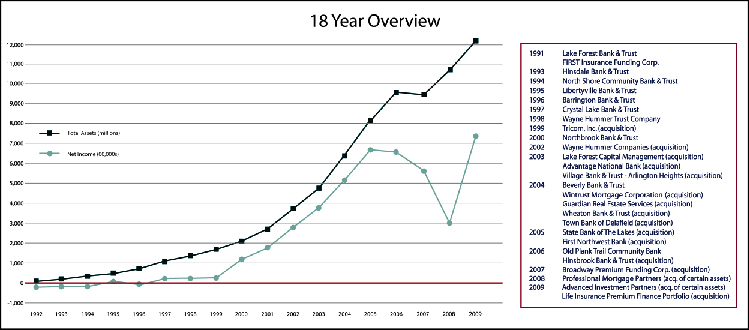
Another of our successes came with personnel. Our community banks hired a number of commercial
bankers from competitors in 2009. Some came from large national banks that reorganized and alienated many of their top producers and others came from our
local peers. All came with the expertise and talent of our current commercial banking teams, as
well as solid customer followings and books of business. Wintrust is quickly becoming known as a
top place to work if you’re a commercial banker in Illinois or Wisconsin.
We’ve seen a similar migration with our wealth management units, with the hiring of additional
financial advisors, asset managers and trust officers in 2009. In some cases, we’ve even hired
entire teams from competitors, allowing us to quickly grow our wealth management business in
several local markets.
Our wealth management group also purchased certain liabilities and assets of Advanced Investment
Partners (AIP) in March. Rolled into Wayne Hummer Asset Management, AIP brought a talented team of
professionals with an impressive track record and a focus on tax-aware and socially responsible
investing.
Our largest success of 2009, of course, was our purchase of a life insurance premium finance
portfolio. In addition to
the $1 billion loan portfolio, increasing the diversity of the Company’s loan mix, at approximately a 30%
discount, this purchase added an experienced, fully staffed loan office in New Jersey. This staff
joined our previously established life insurance premium finance division within FIRST Insurance
Funding Corp. and made FIRST, we believe, the largest life insurance finance company in the nation.
What we did not do, however, was buy other banks. As we stated earlier, it was very important that
we put our own house in order first, before taking on someone else’s problems. This is not to say
that we didn’t look at a few FDIC-assisted transactions in the latter part of 2009. We will
continue to review these opportunities in 2010 and will bid on failed banks if it makes strategic
sense for the Company.
Starting a New Chapter in 2010
Like 2009, 2010 will be the next chapter in the part of a story that started in 2006.
Now, it is likely that this chapter could very well be the climax of this section, as we hope to
see Wintrust returning to is true character — growth and expansion. But, we are “not out of the
woods yet”. As stewards of your Company, we intend to maintain our vigilance in executing the plan
we have laid out.
| 2009 Annual Report | 7 | |
On the surface, our goals for 2010 look a lot like our goals for 2009:
| 1. | Calculated growth on both sides of the balance sheet (loans and deposits). | ||
| 2. | Continue to lower our cost of funds and raise our net interest margin. | ||
| 3. | Clean out problems as they arise. | ||
| 4. | Seek out market dislocations. |
But that’s the great thing about a good novel, the more you read, the more time you spend with the
characters and the plot, the more insight you get into them and the more complex they become.
Restarting the Growth Engine
For those of you who have been long-term shareholders, you can remember Wintrust’s true
personality — solid growth through de novo expansion and acquisition, with organic growth from
existing locations leading the way.
We expect 2010 to be a very opportunistic year for Wintrust. There are a number of areas around
Chicago and southern Wisconsin where we do not have locations. We will be looking to work with the
FDIC on some potential transactions and may even look at non-FDIC assisted deals where they make
sense. (Please see sidebar: “A Quick Note on FDIC Assisted Transactions.”)
Our mortgage, wealth management and specialty finance companies will also be on the look out for
acquisition partners to help them grow market share, move into new territory or enter new lines of
business. Any deal we look at will always have to be priced correctly and be financially prudent
for the Company.
Of course real growth from our existing infrastructure is vital to our overall success. Some of
that growth will be driven by our recently hired commercial loan officers and current commercial
banking teams, as well as our new loan office in downtown Chicago. Populated by some recent
“refugees” from other banks and some existing Wintrust commercial bankers, this office will allow
us to better target downtown companies and centers of influence.
Getting the Word Out
Those of you who live in the greater Chicago area, have probably heard the Wintrust brand
slowly enter the market. We started with our commercial marketing in 2007, pushing our combined
resources, highlighting the “Power of Wintrust” and labeling, for our commercial clients, each of
our banks as “a Wintrust Community Bank.”
In 2008, we started marketing MaxSafe®, “brought to you by your Wintrust Community Banks.” In late
2008 and 2009, we rebranded our mortgage operations into Wintrust Mortgage and marketed the company
throughout the area.

| 8 | Wintrust Financial Corporation | |
In 2010, we will do the same to our wealth management companies. Using the umbrella “a
Wintrust Wealth Management Company,” we will continue to market Wayne Hummer Investments, a
trusted 80 year-old brand. In order to better appeal to institutional customers, we will rename
our asset management unit to Wintrust Capital Management. Our trust company will also take on a
new name that best reflects its strength and heritage.
We also want to make sure that those hit hardest by these economic times know that they can
continue to count on their Wintrust Community Banks for fair and flexible banking solutions. We
will be increasing our outreach efforts by rolling out a number of reasonably priced loan products
for low and moderate income borrowers to turn to rather than the high priced alternatives, as well
as customized checking and savings products that allow the unbanked and under-banked to become part
of the financial system and reach their goals. Being community bankers means providing solutions
for everyone in our communities and we haven’t forgotten that.
Although we are starting to get the word out about Wintrust, our community bank branding has always
been unique. They are true community banks with local leadership, local staff, local boards of
directors and local decision making. Our structure has always given them more strength, flexibility
and resources than a typical community bank.
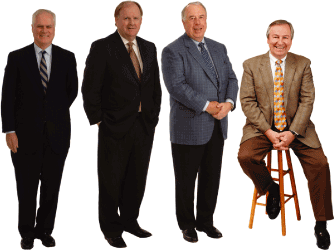
Eleven of the thirteen members of Wintrust’s Board of Directors, please see legend in the Corporate Information
section at the end of this report.
A Quick Note on FDIC Assisted Transactions
One of the most obvious (and publicly disturbing) symptoms of the current economic cycle is a
dramatic increase in the number of bank failures. The last time we saw an economic cycle like this
(the late 1980s — early 1990s) more than 2,000 banks failed nationally. 140 banks failed in 2009.
Banks fail for any number of reasons, though the most common reason usually centers on a
unmanageable amount of bad loans. As the FDIC seizes and closes these banks, they look for
partners to take over responsibility for the assets and deposits of the failed banks.
Purchasing a failed bank from the FDIC can be attractive to the purchasing bank. In many cases:
| • | The acquiring bank does not pay cash for the failed bank’s assets. It assumes the deposits and some other liabilities, and acquires loans and certain other assets, under terms negotiated with the FDIC. | ||
| • | FDIC transactions may be advantageous from a risk-based capital perspective. Depending on the loss sharing arrangement with the FDIC, loans in the acquired portfolio could have risk-based regulatory capital requirements significantly less than the requirement for similar originated loans. | ||
| • | The transactions, many times, are immediately accretive to the acquirer’s net income. |
However, these purchases can also carry risks to the acquiring bank.
| • | After a competitive bidding process, the FDIC usually picks the acquiring bank based on the bank’s willingness to accept risk on the failed bank’s loan portfolio. The bidder willing to take on the most risk frequently wins. | ||
| • | The acquiring bank carries the failed bank’s loans on its balance sheet and reports the failed bank’s (often substantial) non-performing loans with their own loan portfolio. | ||
| • | The acquiring bank does have to work and attempt to collect on any of the acquired non-performing loan portfolio. This usually requires substantial resources. | ||
| • | Based on the structure of the individual purchase, the acquiring bank may be required to make equity related payments to the FDIC, or make payments to the FDIC up to 10 years after the transaction, based on the performance of the acquired asset portfolio. |
As opportunities arise, please know that we have, and will review each carefully, making sure to
only choose those that are the best fit for our organization and offer the best overall value for
our shareholders.
| 2009 Annual Report | 9 | |
This approach will allow our banks to continue to operate as they always have, as true
community banks, while giving us the ability to tell businesses and wealth management prospects
what it means to work with a Wintrust company.
Returning to What We Do Best
In our 2008 report, we stated that we saw the mission of our Banks coming full circle. Our
mission has always been to offer our customers and neighbors a real alternative to the big banks
who believe their market dominance gives them the ability to charge excessive fees while skimping on
service.
We appear to be in an era when the only choices in some parts of the country are banks that are
“too big to fail” and too big to care or small banks with limited resources, limited capital and,
in 140 cases in 2009, limited lifespans.
Families and businesses in the Midwest have an alternative. Wintrust Community Banks give them the
best of both worlds — the products, technology and resources of the big banks paired with the
service and community focus of community banks. Our customers truly get to “Have It All.”
This starts with all of our outstanding employees, as they allow us to provide our core, key
differentiator: Service, Service, Service. Without them, our model would not work.
In addition, our structure and the talented leadership at each of the Wintrust companies has
positioned us to be one of the first ones to exit the current cycle, while allowing us to take
advantage of opportunities that arise.
However, it is important that we remember that we do not operate in a vacuum. The current economic
storm will continue for a while longer. High unemployment, declining real estate values and a
volatile stock market continue to trouble our customers and shake up the marketplace. But it’s just
this type of storm that reveals opportunities for those that have prepared for the storm and allows
customers to see where real strength resides. We believe that 2010 will be another opportunistic
year for Wintrust.
Thank you for being a shareholder. We hope to see you at our Annual Meeting on May 27, 2010 at
10:00 a.m. at the Deer Path Inn, located in downtown Lake Forest.
Sincerely,  Peter D. Crist Chairman |
 Edward J. Wehmer President & Chief Executive Officer |
 David A. Dykstra Senior Executive Vice President & Chief Operating Officer |

| 10 | Wintrust Financial Corporation | |
Key Initiatives for 2010
While we covered a number of our larger 2010 strategic initiatives in the Shareholders
Letter, there are a couple key areas that deserve further explanation.
Enhancing the Customer Experience
The success of all parts of our franchise relies on satisfied and engaged customers.
It is important that all of our banks and
subsidiaries understand that it’s not just the individual transactions that build the customer
experience but every interaction the customer has with us, whether in the bank, on the phone,
on-line or at an event.
Our focus remains on initiatives which bring more people into our locations and
position ourselves as the local financial experts. This year will see a significant
expansion of these efforts, including finance-specific events and seminars,
presentations for home-buyers, small business owners, families and
retirees, and covering a variety
of topics such as fraud prevention, identity protection, Roth IRA conversions, finance for
teenagers, and fixed income investing. “We’ll also use these events to continue our outreach to
the unbanked and underbanked with events and seminars focusing on understanding your credit score,
first time home buyers, financial literacy and credit repair.
Other events focus less on finance and more on customer engagement and loyalty. Our Junior Savers
and Platinum Adventures clubs are perfect examples. While primarily designed to teach children the
importance of saving, our Junior Saver families can count on a number of games, cookouts and other
family events throughout the course of the year to keep them coming to the bank. Our Junior Savers
club will be expanded in 2010 to include teenage customers, focusing on budgeting,
saving and investing with rewards centered around electronics and music.
Our Platinum Adventures customers rely on us for both financial knowledge and fun. One day,
they’ll attend a seminar on reverse mortgages or IRA distributions, the next they could be
attending a Broadway show downtown or practicing Brain Aerobics. Our Platinum Adventures clubs saw
good growth in 2009 and we expect to see further expansion in 2010.
Enhancing the customer experience should also lead to a big expansion of our on-line services. In early months of
2010, we will be rolling out mobile account alerts for all customers, as well as personal finance
management software (PFM). Available free of charge to our customers who use on-line banking, PFM
allows these customers to aggregate all their financial information in one place and make it easier to track
spending, set budgets and financial goals, and gain a clearer understanding of their complete
financial picture.
This year will also see an expansion of our banks’ on-line initiatives, including active use of
social media to engage customers and new web sites that will have tailored content for our retail
customers based on their current stage in life, as well as industry-specific portals for our
commercial and small business customers. We are also providing our small business customers with
their own on-line community, where they can look for opportunities and partnerships and get
advice.
Finally, we want to ensure that our customers are receiving the experience they want. While we have
always welcomed and asked for feedback from our customers, we are putting a more formal program in
place. Our customer feedback program for 2010 will include an on-line component at a “My Bank Idea”
section of our bank web sites, where customers can ask questions, present an idea, give praise or
pose a problem. This will be complemented by more traditional methods including response cards
within the banks and customer surveys.
Going Where the Business Is
The middle market business in our service area has seen a number of banks pull back from lending and reduce the
services they provide. Typically comprised of privately owned businesses, in a variety of
industries, with $10 million to $50 million in annual revenue, the middle market poses a tremendous
opportunity for the Company.
For about two years, we’ve touted to local businesses that they can “Have It All — Big Bank
Resources and Community Bank Service.” The commercial lenders across all our banks took this
message to heart as they pursued small and mid-market businesses across the Chicago suburbs and
southern
| 12 | Wintrust Financial Corporation | |
Wisconsin. Customers and prospects realized that Wintrust Community Banks offered businesses something unique — a best in class suite
of robust and flexible Treasury Management solutions, an experienced and
dedicated commercial, industrial and real estate lending team, and the customer
focus that only comes from working with a community bank.

In 2010, we’re expanding to downtown Chicago via a new loan office with commercial lenders coming
from a number of different national, regional and local banks, joined by some of our current
lenders. The downtown Wintrust Commercial Banking team, operating as a loan processing office of
North Shore Community Bank & Trust, will focus on middle market businesses and the firms that
influence them. We want to truly be Chicago’s business bank.
Expanding Our Niches
While we will always count on core loans and deposits to keep our franchise growing, we’ve
developed a number of specialties that help drive growth.
Due to the current economic conditions, commercial real estate can be a volatile and unpredictable
segment. Two of our niches are well positioned to take advantage of solid opportunities. Our
Community Advantage group, out of Barrington Bank & Trust, continues to
see opportunities with condominium, townhome and homeowner associations and
increased activity from management companies. Also, Wintrust Commercial Realty
Advisors has found new life as a lender to opportunistic commercial real estate
investors. These are smaller loans (generally less than $5 million) maintaining
low leverage and with appropriate rates and fees built into the deals.
Another opportunity has become apparent in the franchise area. Wintrust Franchise
Services, operating out of
Highland Park Bank & Trust, is a national lender to McDonald’s owner/ operators
and is seeing solid growth.
Now believed to be the largest life insurance premium finance lender in the
nation and one of the top property & casualty premium finance
companies, FIRST Insurance Funding Corp. continues to see growth opportunities thanks to industry
consolidation and FIRST’s superior products and service. The recent sale in 2010 of one of the
largest property & casualty premium finance companies in the nation will put even more volume into
play.
Not all of our niches are lending focused. To balance out some of this loan demand, our Treasury
Management and other units are always finding new deposit partnerships. Our wholesale MaxSafe®
product was successful for us in 2009 and can be tapped, as needed for additional liquidity, in
2010. Thanks to MaxSafe® and our local bank and personnel reputations,
Wintrust Government Funds is now one of the top providers of treasury management
and financial services to municipalities in our market areas.
Finally, Wintrust Association Services, operating out of St. Charles Bank &
Trust, has found another underserved market among Chicago’s trade associations
and other not-for-profit organizations. Offering full treasury management and
finance solutions to this market is a promising business opportunity and we count
the Illinois Restaurant Association and its Chicago Gourmet event among our
clients.
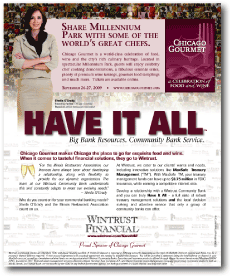
| 2009 Annual Report | 13 | |
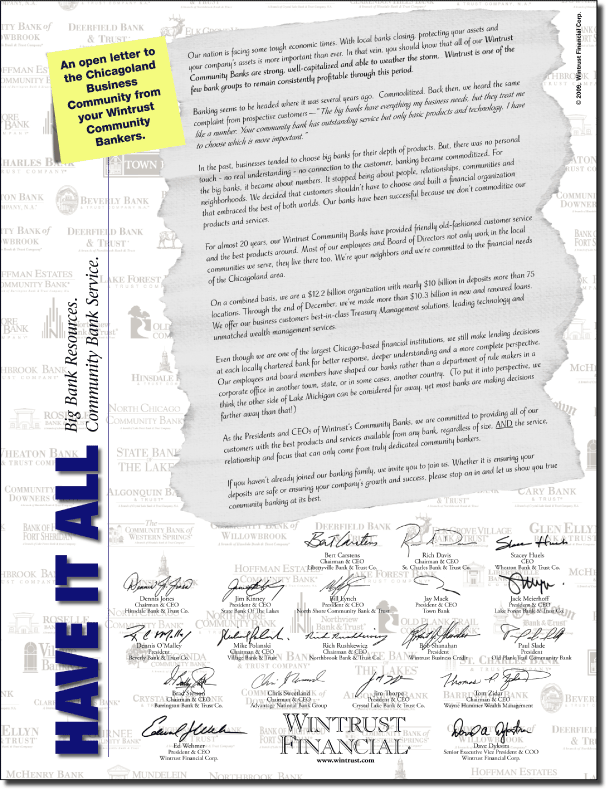
| 14 | Wintrust Financial Corporation | |
Corporate Locations
Corporate Headquarters |
Wintrust Financial Corporation |
727 North Bank Lane |
Lake Forest, IL 60045 |
847-615-4096 |
Illinois Banking &
Wealth Management
Locations |
ALGONQUIN |
Algonquin Bank & Trust |
Wayne Hummer Wealth Management |
4049 W. Algonquin Rd. |
Algonquin, IL 60102 |
847-669-7500 |
ANTIOCH |
State Bank of The Lakes |
Wayne Hummer Wealth Management |
440 Lake St. |
Antioch, IL 60002 |
847-395-2700 |
ARLINGTON HEIGHTS |
Village Bank & Trust |
234 W. Northwest Hwy. |
Arlington Heights, IL 60004 |
847-670-1000 |
Village Bank & Trust |
150 E. Rand Rd. |
Arlington Heights, IL 60004 |
847-870-5000 |
Village Bank & Trust |
Wayne Hummer Wealth Management |
311 S. Arlington Heights Rd. |
Arlington Heights, IL 60005 |
847-483-6000 |
Village Bank & Trust |
1845 E. Rand Rd. |
Arlington Heights, IL 60004 |
847-483-6000 |
BARRINGTON |
Barrington Bank & Trust Company |
Wayne Hummer Wealth Management |
201 S. Hough St. |
Barrington, IL 60010 |
847-842-4500 |
Barrington Bank & Trust Company |
233 W. Northwest Hwy. |
Barrington, IL 60010 |
847-381-1715 |
BLOOMINGDALE |
Old Town Bank & Trust of Bloomingdale |
Wayne Hummer Wealth Management |
165 W. Lake St. |
Bloomingdale, IL 60108 |
630-295-9111 |
BUFFALO GROVE |
Buffalo Grove Bank & Trust |
200 N. Buffalo Grove Rd. |
Buffalo Grove, IL 60089 |
847-634-8400 |
CARY |
Cary Bank & Trust |
60 E. Main St. |
Cary, IL 60013 |
847-462-8881 |
CHICAGO |
Wayne Hummer Wealth Management -
HEADQUARTERS |
222 South Riverside Plaza |
28th Floor |
Chicago, IL 60606 |
312-431-1700 |
Beverly Bank & Trust Company |
Wayne Hummer Wealth Management |
10258 S. Western Ave. |
Chicago, IL 60643 |
773-239-2265 |
Beverly Bank & Trust Company |
1908 W. 103rd St. |
Chicago, IL 60643 |
773-239-2265 |
North Shore Community Bank & Trust Co. |
Wayne Hummer Wealth Management |
4343 W. Peterson Ave. |
Chicago, IL 60646 |
773-545-5700 |
CLARENDON HILLS |
Clarendon Hills Bank |
200 W. Burlington Ave. |
Clarendon Hills, IL 60514 |
630-323-1240 |
CRYSTAL LAKE |
Crystal Lake Bank & Trust Company |
70 N. Williams St. |
Crystal Lake, IL 60014 |
815-479-5200 |
Crystal Lake Bank & Trust Company |
27 N. Main St. |
Crystal Lake, IL 60014 |
Crystal Lake Bank & Trust Company |
1000 McHenry Ave. |
Crystal Lake, IL 60014 |
815-479-5715 |
DEERFIELD |
Deerfield Bank & Trust |
660 Deerfield Rd. |
Deerfield, IL 60015 |
847-945-8660 |
DOWNERS GROVE |
Community Bank of Downers Grove |
Wayne Hummer Wealth Management |
1111 Warren Ave. |
Downers Grove, IL 60515 |
630-968-4700 |
Community Bank of Downers Grove |
718 Ogden Ave. |
Downers Grove, IL 60515 |
630-435-3600 |
ELK GROVE VILLAGE |
Elk Grove Village Bank & Trust |
75 E. Turner Ave. |
Elk Grove Village, IL 60007 |
847-364-0100 |
FRANKFORT |
Old Plank Trail Community Bank |
20901 S. LaGrange Road |
Frankfort, IL 60423 |
815-464-6888 |
GENEVA |
St. Charles Bank & Trust Company |
2401 Kaneville Rd. |
Geneva, IL 60134 |
630-845-4800 |
GLEN ELLYN |
Glen Ellyn Bank & Trust |
Wayne Hummer Wealth Management |
500 Roosevelt Rd. |
Glen Ellyn, IL 60137 |
630-469-3000 |
GLENCOE |
North Shore Community Bank & Trust Co. |
362 Park Ave. |
Glencoe, IL 60022 |
847-835-1700 |
North Shore Community Bank & Trust Co. |
633 Vernon Ave. |
Glencoe, IL 60022 |
GRAYSLAKE |
State Bank of The Lakes |
Wayne Hummer Wealth Management |
50 Commerce Dr. |
Grayslake, IL 60030 |
847-548-2700 |
2009
Annual Report
|
||
GURNEE |
Gurnee Community Bank |
Wayne Hummer Wealth Management |
675 N. O’Plaine Rd. |
Gurnee, IL 60031 |
847-625-3800 |
HIGHLAND PARK |
Highland Park Bank & Trust |
1949 St. Johns Ave. |
Highland Park, IL 60035 |
847-432-9988 |
Highland Park Bank & Trust |
643 Roger Williams Ave. |
Highland Park, IL 60035 |
847-266-0300 |
HIGHWOOD |
Bank of Highwood – Fort Sheridan |
507 Sheridan Rd. |
Highwood, IL 60040 |
847-266-7600 |
HINSDALE |
Hinsdale Bank & Trust Company |
Wayne Hummer Wealth Management |
25 E. First St. |
Hinsdale, IL 60521 |
630-323-4404 |
Hinsdale Bank & Trust Company |
130 W. Chestnut |
Hinsdale, IL 60521 |
630-655-8025 |
HOFFMAN ESTATES |
Hoffman Estates Community Bank |
1375 Palatine Rd. |
Hoffman Estates, IL 60192 |
847-963-9500 |
Hoffman Estates Community Bank |
2497 W. Golf Rd. |
Hoffman Estates, IL 60169 |
847-884-0500 |
ISLAND LAKE |
Wauconda Community Bank |
229 E. State Rd. |
Island Lake, IL 60042 |
847-487-3777 |
LAKE BLUFF |
Lake Forest Bank & Trust Company |
103 E. Scranton Ave. |
Lake Bluff , IL 60044 |
847-615-4060 |
LAKE FOREST |
Lake Forest Bank & Trust Company |
Wayne Hummer Wealth Management |
727 N. Bank Ln. |
Lake Forest, IL 60045 |
847-234-2882 |
Lake Forest Bank & Trust Company |
780 N. Bank Ln. |
Lake Forest, IL 60045 |
847-615-4022 |
Lake Forest Bank & Trust Company |
911 S. Telegraph Rd. |
Lake Forest, IL 60045 |
847-615-4098 |
Lake Forest Bank & Trust Company |
Wayne Hummer Wealth Management |
810 S. Waukegan Rd. |
Lake Forest, IL 60045 |
847-615-4080 |
LAKE VILLA |
State Bank of The Lakes |
345 S. Milwaukee Ave. |
Lake Villa, IL 60046 |
847-265-0300 |
LIBERTYVILLE |
Libertyville Bank & Trust Company |
507 N. Milwaukee Ave. |
Libertyville, IL 60048 |
847-367-6800 |
Libertyville Bank & Trust Company |
201 E. Hurlburt Court |
Libertyville, IL 60048 |
847-247-4045 |
Libertyville Bank & Trust Company |
Wayne Hummer Wealth Management |
1200 S. Milwaukee Ave. |
Libertyville, IL 60048 |
847-367-6800 |
LINDENHURST |
State Bank of The Lakes |
2031 Grand Ave. |
Lindenhurst, IL 60046 |
847-356-5700 |
McHENRY |
McHenry Bank & Trust |
2205 N. Richmond Rd. |
McHenry, IL 60050 |
815-344-6600 |
McHenry Bank & Trust |
2730 W. Route 120 |
McHenry, IL 60050 |
815-344-5100 |
MOKENA |
Old Plank Trail Community Bank |
Wayne Hummer Wealth Management |
20012 Wolf Rd. |
Mokena, IL 60448 |
708-478-4447 |
MUNDELEIN |
Mundelein Community Bank |
1110 W. Maple Ave. |
Mundelein, IL 60060 |
847-837-1110 |
NEW LENOX |
Old Plank Trail Community Bank |
Wayne Hummer Wealth Management |
280 Veterans Pkwy. |
New Lenox, IL 60451 |
815-485-0001 |
NORTH CHICAGO |
North Chicago Community Bank |
1801 Sheridan Rd. |
North Chicago, IL 60064 |
847-473-3006 |
NORTHBROOK |
Northbrook Bank & Trust Company |
1100 Waukegan Rd. |
Northbrook, IL 60062 |
847-418-2800 |
Northbrook Bank & Trust Company |
875 Sanders Rd. |
Northbrook, IL 60062 |
847-418-2850 |
NORTHFIELD |
Northview Bank & Trust |
Wayne Hummer Wealth Management |
245 Waukegan Rd. |
Northfield, IL 60093 |
847-446-0245 |
Northview Bank & Trust |
1751 Orchard Ln. |
Northfield, IL 60093 |
847-441-1751 |
PALATINE |
Palatine Bank & Trust |
Wayne Hummer Wealth Management |
110 W. Palatine Rd. |
Palatine, IL 60067 |
847-963-0047 |
RIVERSIDE |
Riverside Bank |
17 E. Burlington |
Riverside, IL 60546 |
708-447-3222 |
| Wintrust Financial Corporation | ||
ROSELLE |
Advantage National Bank |
1350 W. Lake St. |
Roselle, IL 60172 |
630-529-0100 |
SKOKIE |
North Shore Community Bank & Trust Co. |
7800 Lincoln Ave. |
Skokie, IL 60077 |
847-933-1900 |
SPRING GROVE |
State Bank of The Lakes |
1906 Holian Dr. |
Spring Grove, IL 60081 |
815-675-3700 |
ST. CHARLES |
St. Charles Bank & Trust Company |
411 West Main St. |
St. Charles, IL 60174 |
630-377-9500 |
VERNON HILLS |
Vernon Hills Bank & Trust |
Wayne Hummer Wealth Management |
1101 Lakeview Parkway |
Vernon Hills, IL 60061 |
847-247-1300 |
WAUCONDA |
Wauconda Community Bank |
495 W. Liberty St. |
Wauconda, IL 60084 |
847-487-2500 |
WESTERN SPRINGS |
The Community Bank of Western Springs |
Wayne Hummer Wealth Management |
1000 Hillgrove Ave. |
Western Springs, IL 60558 |
708-246-7100 |
WHEATON |
Wheaton Bank & Trust Company |
211 S. Wheaton Ave. |
Wheaton, IL 60187 |
630-690-1800 |
WILLOWBROOK |
Community Bank of Willowbrook |
6262 S. Route 83 |
Willowbrook, IL 60527 |
630-920-2700 |
WILMETTE |
North Shore Community Bank & Trust Co. |
Wayne Hummer Wealth Management |
1145 Wilmette Ave. |
Wilmette, IL 60091 |
847-853-1145 |
North Shore Community Bank & Trust Co. |
Wayne Hummer Wealth Management |
720 12th St. |
Wilmette, IL 60091 |
North Shore Community Bank & Trust Co. |
351 Linden Ave |
Wilmette, IL 60091 |
WINNETKA |
North Shore Community Bank & Trust Co. |
576 Lincoln Ave. |
Winnetka, IL 60093 |
847-441-2265 |
Wisconsin Banking &
Wealth Management
Locations |
APPLETON |
Wayne Hummer Wealth Management |
200 East Washington Street |
Appleton, WI 54911 |
920-734-1474 |
DELAFIELD |
Town Bank of Delafield |
400 Genesee St. |
Delafield, WI 53018 |
262-646-6888 |
ELM GROVE |
Town Bank of Elm Grove |
13150 Watertown Plank Rd. |
Elm Grove, WI 53122 |
262-789-8696 |
HARTLAND |
Town Bank |
Wayne Hummer Wealth Management |
850 W. North Shore Dr. |
Hartland, WI 53029 |
262-367-1900 |
MADISON |
Town Bank of Madison |
10 W. Mifflin St. |
Madison, WI 53703 |
608-282-4840 |
WALES |
Town Bank of Wales |
200 W. Summit Ave. |
Wales, WI 53183 |
262-968-1740 |
FIRST Insurance
Funding Corp. |
450 Skokie Blvd., Suite 1000 |
Northbrook, IL 60062 |
847-374-3000 |
FIRST Life Funding |
101 Hudson Street, 35th Floor |
Jersey City, NJ 07302 |
201-332-7349 |
Broadway Premium
Funding Corporation |
1747 Veterans Memorial Highway |
Suite 22 |
Islandia, NY 11749 |
212-791-7099 |
Tricom, Inc. of
Milwaukee |
N48 W16866 Lisbon Road |
Menomonee Falls, WI 53051 |
262-509-6200 |
Wintrust Mortgage
Corporation |
Headquarters |
1 South 660 Midwest Rd., Suite 100 |
Oakbrook Terrace, Illinois 60181 |
630-916-9299 |
Branch Offices |
Phoenix, AZ |
Denver, CO |
Madison, GA |
Barrington, IL |
Champaign, IL |
Chicago, IL |
Downers Grove, IL |
Elmhurst, IL |
Frankfort, IL |
Geneva, IL |
Glen Ellyn, IL |
Mokena, IL |
Naperville, IL |
Northbrook, IL |
Northfield, IL |
Oakbrook Terrace, IL |
Schaumburg, IL |
Tinley Park, IL |
Willowbrook, IL |
Crown Point, IN |
Overland Park, KS |
Louisville, KY |
Hanover, MD |
Pataskala, OH |
Madison, WI |
2009 Annual Report
|
||
Corporate Information
Directors
Peter D. Crist (Chairman)
Bruce K. Crowther
Joseph F. Damico
Bert A. Getz, Jr.
H. Patrick Hackett, Jr.
Scott K. Heitmann
Charles H. James, III
Albin F. Moschner
Thomas J. Neis
Christopher J. Perry
Hollis W. Rademacher
Ingrid S. Stafford
Edward J. Wehmer
Peter D. Crist (Chairman)
Bruce K. Crowther
Joseph F. Damico
Bert A. Getz, Jr.
H. Patrick Hackett, Jr.
Scott K. Heitmann
Charles H. James, III
Albin F. Moschner
Thomas J. Neis
Christopher J. Perry
Hollis W. Rademacher
Ingrid S. Stafford
Edward J. Wehmer
Public Listing and Market Symbol
The
Company’s Common Stock is traded on The NASDAQ Global Select Market® under the symbol WTFC.
Website Location
The
Company maintains a financial relations internet website at the following location: www.wintrust.com
Annual Meeting of Shareholders
May 27, 2010
10:00 a.m.
Deer Path Inn
255 E. Illinois Road
Lake Forest, Illinois 60045
10:00 a.m.
Deer Path Inn
255 E. Illinois Road
Lake Forest, Illinois 60045
Form 10-K
The Annual Report on Form 10-K to the Securities and
Exchange Commission is contained herein this document.
The information is also available on the Internet at the Securities and Exchange Commission’s website. The address for the
web site is: http://www.sec.gov.
Transfer Agent
Illinois Stock Transfer Company
209 West Jackson Boulevard
Suite 903
Chicago, Illinois 60606
Telephone: 312-427-2953
Facsimile: 312-427-2879
209 West Jackson Boulevard
Suite 903
Chicago, Illinois 60606
Telephone: 312-427-2953
Facsimile: 312-427-2879

Wintrust Board of Directors Legend
Page 8, (pictured from left to right): Charles H. James, III, Bert A. Getz, Jr., Joseph F. Damico,
Christopher J. Perry, Ingrid S. Stafford, Bruce K. Crowther, and Scott K. Heitmann. Page 9: H.
Patrick Hackett, Jr., Thomas J. Neis, Hollis W. Rademacher, and
Albin F. Moschner. Page 10: Peter D. Crist and Edward J. Wehmer.
| Wintrust Financial Corporation | ||

